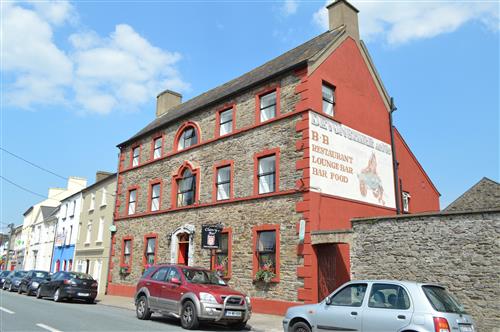Clancy's Guesthouse

Previously called the Devonshire Arms, Clancy’s Guesthouse was originally a Bianconi coach stop, this stone faced building is an end-of-Terrace five-bay three-storey hotel. The frontage would have originally been rendered and still retains the rendered quoins and rendered courses to each floor.
Windows openings are square headed with rendered keystones on the four outside bays and the middle bay features a Venetian style window at the first floor with red bricks forming a segmental relieving arch and a red brick surrounded Diocletian opening at the top floor. Three stone cut steps lead up to a shallow segmental-headed door opening. The building also features an original courtyard which reminds us of its particular importance in the locality due to its importance as a Bianconi Coach Stop on the Clonmel to Waterford Route.
Bianconi was the founder of public transportation in Ireland before railways. He created and established a regular horse drawn carriage service on various routes around Ireland from about 1815 onwards. Carlo or Charles Bianconi originally came from Italy on September 24th 1786 and subsequently became well known for his innovations in transport and attained the prestigious title of Mayor of Clonmel twice. The transport network he established covered Munster, the midlands and the north west, its purpose was to link towns in particular market towns. Travelling on one of his coaches cost a penny farthing a mile making it an affordable way to travel. Eventually the largest of his cars used four wheels, and up to four horses enabling them to carry 16 passengers at a time. He eventually had 100 vehicles travelling 3,800 miles daily calling to 120 towns and 140 stations for changing horses. Tallow and the Devonshire Arms being one of these. Each station employed up to 8 grooms and 1,300 horses were needed to pull the cars. The horses ate around 3,500 tons of hay per year plus 35,000 barrels of oats. This obviously provided much employment around the stations.
The Bianconi cars were known as Bians and by 1857 opened up Ireland to trade and tourists. More people could get to markets around the country, for example fish caught in Galway could be sold in Waterford or Cork the day after being brought to shore. The mail system became more efficient and speedy. The cars were safe and became a popular way of travelling as they could travel anywhere within Ireland both in troubled and peace times without disturbance.

